If you've never had real maple syrup, do yourself a favor and try some. If, like most people, you become immediately addicted, then this post may be your next step to a lifetime of happy tastebuds! If you're just looking to learn a little about tapping trees, skip to the paragraph immediately above the first picture. If you enjoy a leisurely stroll through someone else's thoughts, then read on!
Did you know that you can tap more than just maple trees? I've known that for a while now, but haven't had any success so far with anything but maple trees. Sap from different trees is supposed to make different tasting syrups, and I can confirm that birch syrup has a wintergreen kind of flavor. I've read that sycamore trees make a butterscotch flavored syrup, which is something I really hope to test this year. Other trees I've read you can tap are black walnut (confirmed) and hickory (not confirmed). I believe that there are other nut trees that can be tapped, but none of them grow on my land so I've forgotten what they were.
In this post I'll talk about how you can get started tapping your own trees for well under $20. I'll also share what I know about turning your maple sap into syrup, but I haven't had the pleasure of making any other syrups from sap yet. If you have any information on tapping other types of trees, I would love it if you could share in the comments, or in a post, or in any other form. I've found it particularly hard to get solid info on tapping any trees besides maple and birch.
I will not go into tree identification in this post, so if you're not sure what kind of trees you have, you'll have to learn that elsewhere. I can say that unless you have some very specific disease or insect problems in your area, drilling a small hole and inserting a spile into a tree will not hurt it, so don't worry too much about damaging a tree if you want to see if sap will run out of it. I'm not aware of any tree saps that are poisonous, but I would still advise extreme caution if you want to go tasting any strange saps you're not completely sure about.
So, what do you need to tap some trees? Trees, first of all, that are at LEAST 4" in diameter at chest height. If you don't have any of your own, ask other people with trees if you can tap theirs, most will be more than happy to let you in exchange for a small amount of syrup. The second thing you'll need is spiles, and these come in a variety of forms. I use newer style plastic spiles like the ones in the picture below, which I purchased a 10 pack of on Ebay for about $12, roughly 8 years ago. I still have and use 8 of those 10 spiles, and I'm looking to buy some more this year. I've used these for 6 of the 8 years I've had them, so they're pretty durable. The only problem is that little bits of the ends are prone to breaking off, which is why these are three different sizes. The blue plastic tubing also came with the $12 set.

The third thing you'll need is a drill bit, and the size will depend on the spiles you get. For these plastic spiles, I use a 5/16" drill bit, which is a nice tiny hole in the tree that will heal up really fast once the spile is removed. Some of the older steel spiles would use a hole up to 1/2", which makes a wound with more than twice as much surface area as the 5/16" hole, although trees still heal from these holes pretty fast. You'll want to sterilize your drill bit before you drill your trees with it, even if it is brand new. New drill bits will have oil on them that could hinder the tree's healing. Making syrup, especially in this 'small batch' style, is a time consuming process, so it's good to get everything as sterile as possible before starting to minimize the chance of any mold, fungus, spoiling, or fermentation. I prefer to sterilize with alcohol instead of bleach because chlorine is very corrosive, both to the metal drill bit and the plastic spiles.
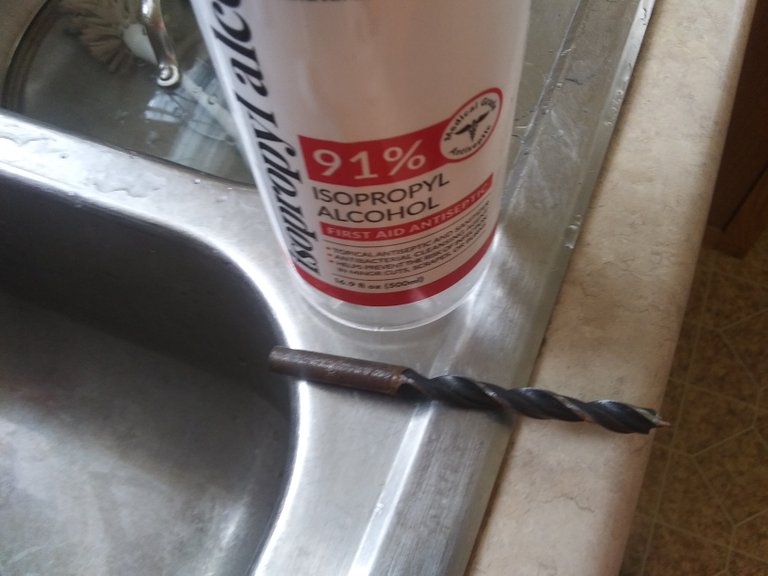
The spiles and tubing I sterilize by boiling. This ensures that no alcohol gets mixed in with my sap, and it makes the tubing more flexible and easier to set up. I recommend a full boil for at least two minutes, but I usually leave mine boiling the whole time that I'm cleaning jugs. The boiling water isn't hot enough to damage them.

You may have seen maple tapping operations where they run hundreds of feet of this tubing and connect it so all the sap runs into a huge barrel or tote. I don't have that kind of money laying around, so I need a collection jug for each spile I use. These classic gallon jugs work just fine, though I prefer to use water or juice jugs over milk jugs. These need replacing more often than the spiles, but I still get at least two years use out of these containers, as long as the raccoons don't eat them.
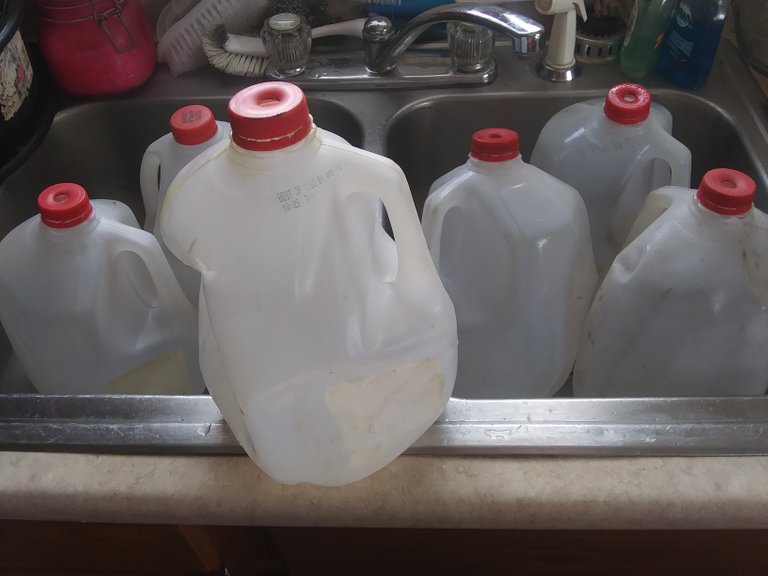
Exposure to sunlight degrades this (and most) plastic, so I make sure there aren't any cracks in my old containers before using them. Big splits like you see in the picture below are easy to spot, but sometimes they'll develop very small hairline cracks that aren't so east to see. To check for these, I fill the jugs with water and let them sit in the sink. If there is a leak, you'll see the water level go down after an hour or two.
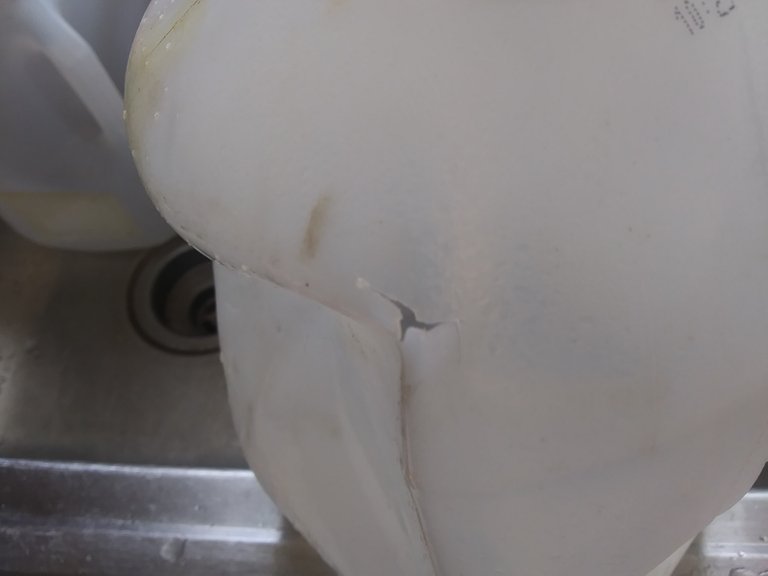
I put holes in the lids to feed the tubing from the spiles into the jugs. Milk jug lids are made of fairly flexible plastic, so you can poke any small hole in them and force the tubing through. They will seal better around the tubing if you drill a hole slightly smaller than the tubing, as seen below.
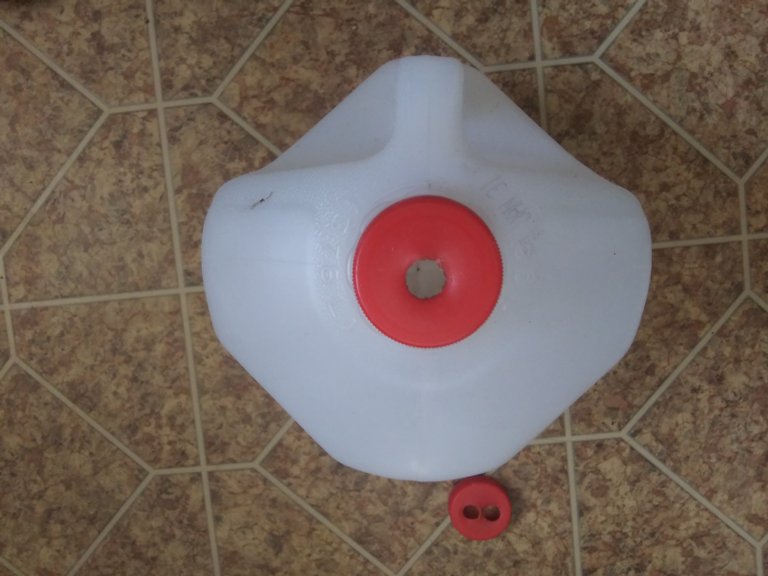
Now that you have all your gear gathered, it's time to go poke some holes in trees! You only need to drill in an inch to successfully tap a maple or black walnut tree, I'm not sure if that depth varies for other trees. If you're not good at guessing how deep you're drilling, mark your drill bit with a piece of tape. After you drill your hole, just tap the spile in gently until it quits going deeper. I do my drilling with a cordless drill, and tap the spiles in with the back side of the drill, usually just three or four little hits. Sometimes the spiles that have bits of the end broken off go in a little harder.
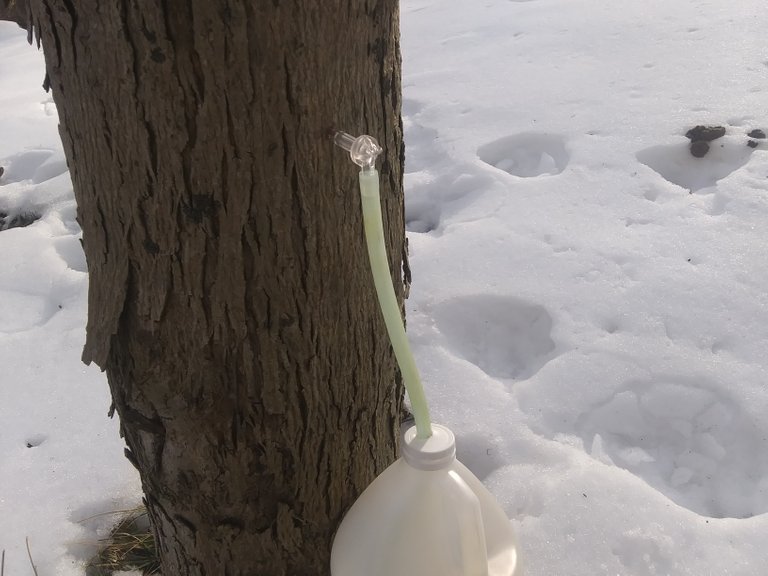
Knowing when to tap your trees is probably the trickiest part. For maple, sap will start flowing around the time you get your first day over 35°F in February (or March, if it's a cold February). The sap flow in maple trees is apparently driven by the daily freeze/thaw cycle, and sap will flow best when daytime temps are between 32°F and 40°F, and nighttime temps go down to the mid 20's or lower. This year I was finally able to tap a black walnut, and it seems to be flowing in the same time frame. I believe that hickory trees need to be tapped sooner, and that is why I haven't had any luck with them. I've read that birch trees start flowing right after maple trees stop, and hope to confirm that this year. For maple and birch, you can leave the taps in until the sap become cloudy, which for maples usually happens when days start getting warmer than 45. At this point the sap becomes more sour than sweet, and won't make good syrup.
The picture below is of my first tap in a black walnut. The sap is already quite a bit darker than maple sap, and I'm not sure if this is normal, or if it's already too late to gather sap from these trees. I'll find out soon enough, and I'll share what I learn with all of you! The walnut does not seem to produce nearly as much as a maple, this tree only yielded about a cup of sap in a day.
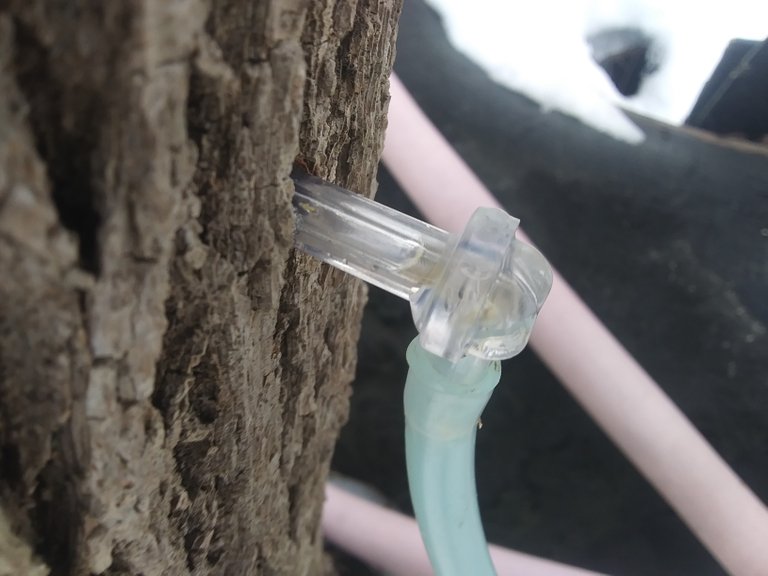
Maple sap is as clear as water, and doesn't taste that much different from water either. The sugar content is minuscule, and a gallon of good sap will make less than a quarter cup of good syrup. Different types of maple tree have different sugar content, with sugar maple of course being the highest, but all maples have enough that their sap can be made into syrup.
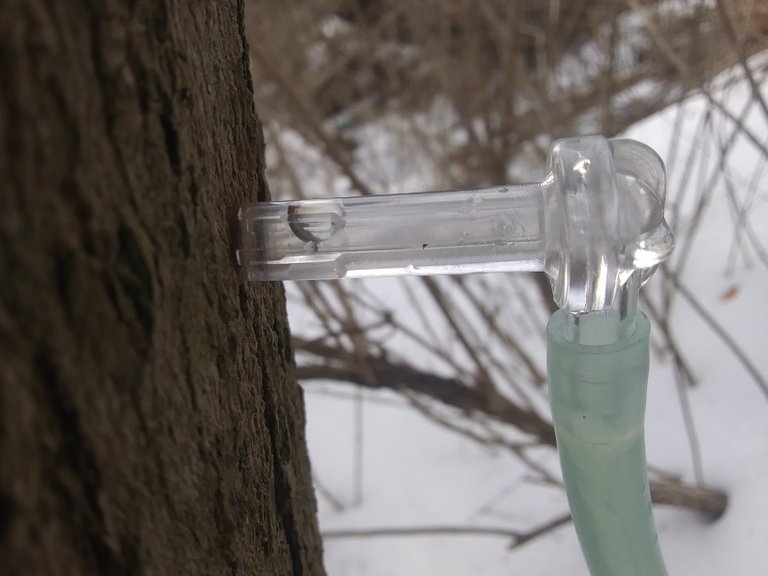
My best maple trees will yield about a gallon of sap on a great day, most days I'll get between 1/2 and 3/4. To collect the sap I go to each of my trees and empty their jug into this five gallon pail. This is the same pail I use for collecting brassica seeds during the summer and fall.
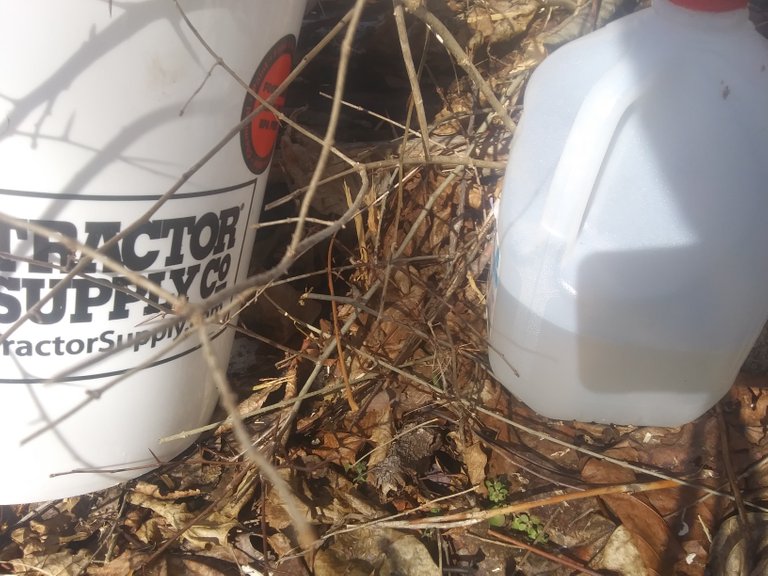
Most of my ground is still covered in snow and ice, so I'm thankful that so far my pail is only about half full when I come back to the house. The sap has to be gathered every day, and this adds about 20 minutes on to my daily chores, but sap season only runs (haha) for a little over a month, so it's not an awful lot of extra work, and the half gallon or more of maple syrup I typically end up with is well worth it!

I have some pictures of my setup for cooking down the sap, but rather than spend an hour digging for those old pictures, I'll do a short description for now, and a separate post about that process later. I heat my home with a kerosene heater, and I simply set a 4 gallon stock pot on top of my kerosene heater and fill it with the sap. This steams off water at just about the perfect rate for me to fill every day. If the level gets too low, I just take it off the heat until I have more sap to add. After about a week you can start to see and smell the emerging syrup when it cooks down. I finish my syrup off on the stove top, but I'll go into more detail about that in the next post.
For now, I hope I've inspired you to make some of your own maple syrup! If you have any questions about getting started, or any info on tapping other trees, please let me know in the comments. Thanks for stopping by, and until next time, try not to believe in the impossible!
Fascinating. We don't really have native trees that can be tapped in our dry landscape, I had no idea this was a thing until a Polish friend told me about it
Very cool post about other tree syrups. I knew some of them but not all.
Congratulations @paradoxtma! You have completed the following achievement on the Hive blockchain and have been rewarded with new badge(s) :
Your next target is to reach 3000 upvotes.
You can view your badges on your board and compare yourself to others in the Ranking
If you no longer want to receive notifications, reply to this comment with the word
STOPCheck out the last post from @hivebuzz:
This is awesome man. True maple syrup is one of the most incredible things to have! I feel bad for the folks who think the corn syrup crap is maple syrup.
We have some maple trees around but I don’t know if we could tap them, the old folks that live in the complex complain if I throw compost in the woods, never mind drill a hole in a tree lol. I’ll see what’s up at the lake house though, we have a bird tree right in the yard.
When I was reading it I was thinking the tap you are using is tiny! But it makes sense, smaller hole and better healing for the tree. Good stuff!
Thank You & Thank You!
I am probably moving to a colder climate, so I may try this!
You have a Wonderful Weekend & Stay Safe!
👍🏼😊😄😊👍🏼